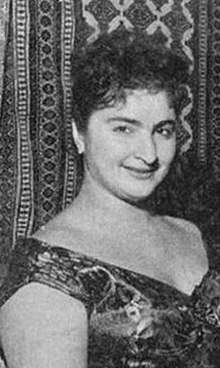Mahvash
Mahvash (Persian: مهوش) born Masoumeh Azizi Borujerdi (Persian: معصومه عزيزى بروجردى) was a singer, dancer, film actress and stage performer.[1] She came from a poor family and was lauded as a singer (performer) of the people in the 1950s.[2]
Mahvash مهوش | |
|---|---|
 | |
| Background information | |
| Birth name | Masumeh Azizi Borujerdi معصومه عزيزى بروجردى |
| Also known as | Mahvash Akram, Banu Mahvash, Ma'sumeh Azizi Borujerdi, Akram Ābgūshtī |
| Born | 1920 Borujerd, Iran |
| Origin | Tehran, Iran |
| Died | 1961 (aged 40–41) Arak, Iran |
| Occupation(s) | Singer, dancer, stage performer |
| Years active | 1950–1961 |
Biography
Mahvash was born Masoumeh Azizi Borujerdi in Borujerd, Iran to a poor family, when Mahvash was a teenager the family came to Tehran. At an early age, Mahvash lost her mother. Later she went on to perform in Tehran's cabarets and cafes and drew large support from the working people. However, there is confusion around her biography, and different accounts of what type of performances were happening at this age and where.[3] The most common story is that she performed risqué songs in the cabarets, on the radio and in movies.[4] She gained the admiration of the masses’ by articulating in her songs the problems, difficulties, and frustrations of the common people, struggles which she knew very well.[1] Her most famous songs involved a call and response-style singing with her male audience.[4]
She published a book in 1957 which she termed an "autobiography" which was entitled Secrets of Sexual Fulfillment (Persian: Raz-e Kamyabi-ye Jensi). This book was more of a sex manual had pictures of her in a bathing suit and was published and widely distributed despite being prosecuted for the book in June 1960.[4] It seems that Mahvash's ability to speak to the marginalized majority absolved her of her forays into prostitution and other publicly indecent behavior.
When Mahvash died in a car accident in 1961, her public funeral went down in Iran's history as the largest of its day, with thousands of Iranians on the streets to mark her passing.[2] Iranian religious authorities were unwilling to accept burying her in a Muslim cemetery because as an entertainer she was considered "unclean" and "unchaste",[4] however when the large amount of mourners celebrated her passing they relented.[4]
She is buried in the Ibn Babawayh Cemetery in Tehran.
Filmography
Acting
- 1956, The Sun Shines, with director Sardar Saker[4]
- 1956, Layla and Majnun (Persian: Leyli va Majnun), with director Ali-Mohammad Nourbakhsh[5]
- 1959, Daughter of Isfahan
- 1959, Two Brides for Three Brothers (Persian: Do arus baraye se baradar), with director Reza Abdi[5]
- 1961, What's the Difference (Persian: Ki Be Kiyeh), with director Reza Karimi[5]
Singing
- 1962, The Lost Flower, (also featured dancing) with director Abbas Shabaviz[5]
See also
- Persian dance
- Persian pop music
References
- Matthee, Rudolph (Rudi); Baron, Beth (2000). "Iran and Beyond: Essays in Middle Eastern History in Honor of Nikki R. Keddie". "Voices Unveiled: Women Singers in Modern Iran,” Chehabi, Houchang E. Costa Mesa, Calif.: Mazda Publishing. ISBN 1-56859-099-7. Retrieved October 17, 2014.
- "Big Girl, Iran's Mahvash". Six Pillars. April 24, 2013. Retrieved October 17, 2014.
- Breyley, GJ; Fatemi, Sasan (2015). Iranian Music and Popular Entertainment: From Motrebi to Losanjelesi and Beyond. Routledge. ISBN 1317336798.
- Naficy, Hamid (September 16, 2011). A Social History of Iranian Cinema, Volume 2: The Industrializing Years, 1941–1978. United States: Duke University Press. ISBN 0822347741.
- "Mahvash". Soureh Cinema. SourehCinema.com. 2013. Retrieved October 17, 2014.